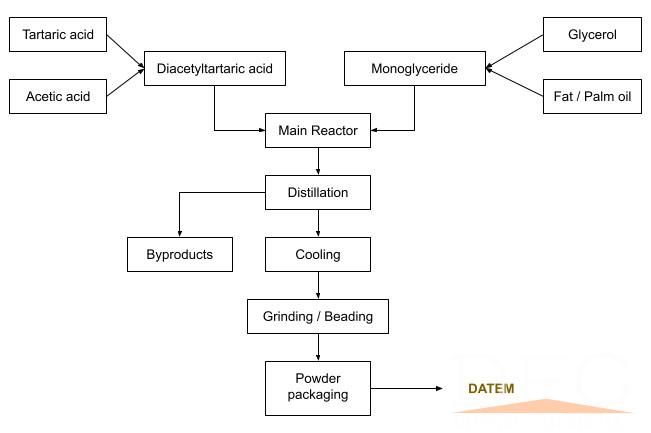Diacetyl Tartaric Acid Ester of Mono- and Diglycerides (DATEM)- DATEM in bread
Also known as diacetyl tartaric acid esters of mono- and diglycerides of fatty acids
What is DATEM (DATEM in bread)?
Diacetyl tartaric acid esters of mono- and diglycerides of fatty acids, or simply DATEM (DATEM in bread), is an emulsifier used in bread making to strengthen the dough structure so that it can successfully expand during proofing and baking.
This emulsifier helps:
• increase volume in a variety of products
• provide a very uniform and fine crumb grain in bread and buns
Origin
DATEM in bread is a food additive that is commercially produced from mono- and diglycerides derived from vegetable oils and/or fats that have been esterified with organic acids.
Function
It is used in bread, buns and many other yeast-leavened bakery products at levels of 0.2–0.6% (based on flour weight). DATEM in bread possesses excellent dough strengthening properties due to its ability to adsorb at the gas/liquid interface of dough and stabilize the foam structure trapped by the gluten matrix and prevent gas bubble coalescence.1,2 So, DATEM in bread enhances gas (CO2) retention and improves tolerance to shocks in case of mechanical abuse during final proofing and baking.
Due to its anionic nature, DATEM in bread also has the capacity to interact with gluten proteins, promoting protein aggregation.2
Commercial production
DATEM in bread are composed of:
1. Glycerol derivatives esterified with edible fatty acids, and
2. Mono and diacetyl tartaric acids.
There are two different processes needed for the production of these species that make up DATEM in bread:
1. The esterification of mono- and diglycerides with tartaric and acetic acids in the presence of acetic acid anhydride.
2. The reaction of diacetyl tartaric acid in the presence of acetic acid with mono- and diglycerides. First, the diacetyl tartaric acid is produced from the reaction of diacetyl tartaric acid with acetic acid. The acetic acid generated in this reaction has to be removed by distillation. The final reaction with monoglycerides is possible once acetic acid is removed.

Application
For ease during scaling and handling, DATEM in bread is usually sold as a powder. The powder form also allows for a cost-effective logistics between supplier and bakery and a lower carbon-footprint in the bakery supply chain.
Properties of commercial DATEM in bread include:
• Melting point: about 45°C. True melting point depends on the chain length and saturation of the fatty acids present in the molecule)
• Powder with 2% moisture (max)
• Purity indicador (total tartaric acid content): min. 10, max. 40%
• Solubility in water at 20°C: dispersible
• Solubility in vegetable oils at 20°C: partially soluble
• HLB value: 9–10 (excellent oil-in-water emulsifier)
• Amylose complexing index (crumb softening ability): 49 (fair)
• Synergistic ingredients: SSL, CSL
In practice, DATEM in bread may help:
• Reduce levels of vital wheat gluten
• Increase water absorption slightly
• Decrease amount of yeast needed for optimum dough expansion during oven spring
• Increase dough tolerance to over-proofing caused by unexpected line stoppages
Regulation
DATEM in bread is a controlled food additive under the E-number 472. It holds a GRAS status by the FDA.3
In the EU, DATEM (E472e) is authorized as a food additive (EC-Regulation, No. 1333/2008).
Contact: DFC Chemical
Phone: +86-13663722676
E-mail: andy@dfcchemical.com
Add: No. 37 Yuxiang Road, High Tech Zone, Zhengzhou City, Henan, China